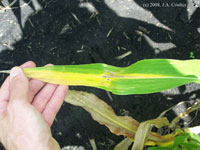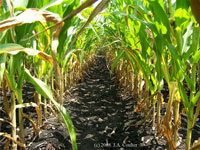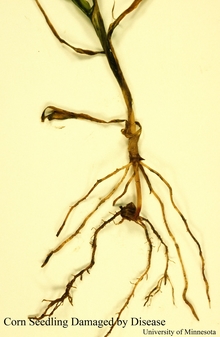Heavy rains can flood corn fields or create saturated conditions. Here, we discuss agronomic and disease issues when corn is exposed to prolonged periods of high soil moisture and cool temperatures.
Agronomic considerations
Growth and development
Young corn can survive flooded conditions lasting for about two days under warm temperatures (at or above the mid-70s, in degrees Fahrenheit) to four days under cooler temperatures (at or below the mid-60s).
How much of the plant was submerged and how quickly the water recedes influences survivability. Corn plants that survived flooded conditions should show new leaf development within three to five days after water recedes.
Flooded and saturated conditions also restrict root development, reducing the crop's ability to take up water and nutrients and tolerate drought stress later in the season.
How flooding or ponding affects corn prior to tasseling
Replanting
University of Minnesota Extension corn replant guide
For grain production, do not plant corn after June 15 in southern Minnesota or after June 5 for central to northern Minnesota. Growers could plant corn for silage as late as June 25 in southern Minnesota. When replanting, make sure to plant corn hybrids of appropriate relative maturity for the shortened growing season.
Corn planted in mid-June or later has a high risk of getting frozen in the fall before it reaches physiological maturity, even if an early-maturity hybrid is selected.
Nitrogen management considerations
With the exception of urea-ammonium nitrate (UAN) solutions that contain 25 percent of the total N as nitrate or ammonium nitrate that contains 50 percent of the total N as nitrate, most commercial fertilizers used today are in the form of ammonium (NH4+) or forms that rapidly transform to ammonium, like anhydrous ammonia and urea. In the ammonium form, N is retained in the exchange sites of soil particles and organic matter.
The transformation of ammonium to nitrate, or nitrification, is done by soil bacteria that need oxygen.
Nitrification potential
In fields where ammonium-based fertilizers were applied within a few days before soil conditions became excessively wet, there’s minimum potential for N loss from the fertilizer because the fertilizer doesn’t have enough time to nitrify.
Because urea is soluble in water, the only concern would be if substantial precipitation occurred soon after applying urea in well-drained fields. In sandy soils or heavily tile-drained soils, it’s possible to move urea or nitrate as much as a foot for each inch of rain. On the other hand, movement is only approximately 5 to 6 inches for each inch of rain in a clay loam or silt loam soil.
That said, between rain events nitrate will start to move back up as evaporation from the soil surface creates an upward suction force that moves water and nitrate closer to the surface. Similarly, evapotranspiration from actively growing crops will result in a similar suction force in addition to some nitrate uptake by the crop.
Nitrogen loss will occur in fields where N from fertilizer or organic N from the soil was present in nitrate form before the soils became excessively wet. In fine-textured soils, water-saturated conditions cause N loss through denitrification.
Denitrification rates increase after about a day under oxygen-depleted conditions that result when soil pore space fills with water. Under these conditions, soil microbes utilize nitrate for respiration, and N is released as a byproduct in gaseous forms that are lost to the atmosphere.
For each day the soil remains saturated with water under warm soil temperatures, it’s possible to lose as much as 5 percent of the soil’s nitrate-N. In coarse-textured soils or intensively tiled soils, N loss occurs mostly by leaching below the root zone or into tile lines.
Symptoms of nitrogen deficiency
Nitrogen deficiency is characterized by yellowing along the leaf midribs, starting at the leaf tip and moving toward the stalk (Figure 1). You’d first observe nitrogen deficiency on the plant’s lowest leaves.
The chlorotic areas will turn brown as the season progresses (Figure 2). Severe N deficiency will result in a poorly developed crop canopy that’s unable to intercept all sunlight during grain fill. Nitrogen-deficient leaves also have a lower capacity for photosynthesis, further limiting the potential for grain fill.
The amount of nitrogen taken up by the corn plant depends on its growth stage.
Nitrogen uptake by corn from emergence through the V6 (six-leaf collar) stage only represents about 5 percent of the total plant uptake. However, starting at about the V8 (eight-leaf collar) stage, the plant rapidly accumulates N, with about 60 percent of the total N uptake occurring between V8 and silking.
This is why it’s important to detect N-deficient areas early, and to sidedress supplemental N on these areas as soon as possible.
When to apply supplemental N
To determine whether to apply supplemental N in corn, consider the in-season corn N calculator.
This worksheet is more accurate when corn is at the V5 or V6 stage rather than when it is smaller. For entire fields or portions of fields meeting the supplemental N requirements, this worksheet recommends a rate of 40 to 70 pounds of N per acre, depending on the situation.
When N fertilizer costs are high, producers planning to apply supplemental N based on this worksheet need to have a have a clear idea about how much N they should apply.
How much supplemental N to apply
Research showed that supplemental N applied at 30 to 40 pounds of N per acre is sufficient for corn following soybean on most soils or corn following corn on medium-textured soils such as silt loams.
You may need higher rates, possibly up to 60 to 70 pounds of nitrogen per acre, on heavy (finer textured) soils where corn follows corn and have high amounts of surface residue.
Seedling diseases
Flooded and wet soil conditions increase the risk of seedling diseases (Figure 3), which may become a problem in flooded fields.
Favorable conditions for seedling diseases include wet and compacted soils, slow plant emergence and growth, crusted soil and poor seed quality.
Diseases can reduce plant and root growth, plant population and, ultimately, yield. Non-lethal infection at the seedling stage may cause damage that persists through the growing season.
Problematic pathogens
The soilborne pathogens that cause these problems are widespread and persistent in Minnesota fields, and can cause damage when conditions develop that favor them. Several different pathogens and diseases can become problematic.
For example, wet and flooded soils are especially favorable for the soilborne, moisture-loving pathogens like Pythium, which appears to cause most damage to corn and soybean seedlings.
Ritchie, S.W., Hanway, J.J. & Benson, G.O. (1997). How a corn plant develops. (Special Report 48). Ames, Iowa: Iowa State University.
Scott, H.D., DeAngulo, J., Daniels, M.B. & Wood, L.S. (1989). Flood duration effects on soybean growth and yield. Agronomy Journal, 81, 631-636.
Sullivan, M., VanTooai, T., Fausey, N., Beuerlein, J., Parkinson, J., & Soboyejo, A. (2001). Evaluating on-farm flooding impacts on soybean. Crop Science, 41, 93-100.
Reviewed in 2021




